|

by
Alex Ansary
February 25, 2009
from
OutsideTheBox Website
|
Alex Ansary was born on
February 25th, 1980 in Portland, Oregon. Since his early youth, he
has been questioning the very nature of reality. His journey
expanded into publicly pondering just what is taking place on the
planet today with the rise of the
New World Order and other coming
changes to our planet and solar system.
'Outside the Box' gives voice to those normally censored or attacked
in the mainstream media. The program aims to connect the dots behind
world events and to provide a sense of hope during these turbulent
times. He challenges his viewers to take responsibility for their
own lives and to help create a real world of change without
compromising our integrity and demand for accountability.
Alex resides in the Pacific Northwest
and participates in the global battle for freedom utilizing cable
television, internet radio, and the world wide web.
Catch the daily radio show at
oraclebroadcasting.com from 1 pm to
3 pm Pacific Time. Feel free to call us during the show and join the
conversation. The number is 866-841-1065.
Click here to return to the homepage and watch the latest TV show...
alex_ansary@hotmail.com
PO Box 12743 -
Portland, Oregon 97212 |
Introduction
If you were thinking that the only things we have to be concerned
about include wars, famines, and economic crashes, think again.
New scientific discoveries are
indicating that this next solar flare cycle could potentially be
powerful enough to disrupt our planet's entire electric grid. In
this report, I will document the number of changes taking place with
our magnetic field, the sun and our solar system while explaining
some of the concerns that today's leading scientists have voiced.
I will also be examining how humankind
may also be affected energically.
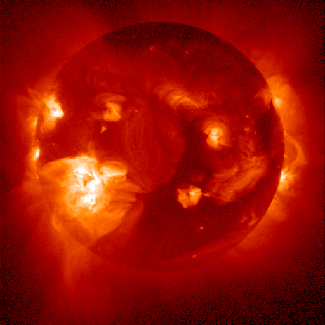
What is Electromagnetic Pollution?
TV, cell phone towers, power lines,
and house appliances - while they make lives more convenient for some,
they also contribute to polluting our electromagnetic atmosphere. A
growing number of scientists, health care professionals, and
concerned citizens argue that these invisible frequencies are
responsible for a host of various health problems.
Meanwhile, the largest polluter has gone
unnoticed: the sun.
And it's about to fire up again.
Our Planet's
Magnetic Field
The magnetosphere is a bubble of magnetism that surrounds Earth and
protects us from solar wind. Fortunately, our planet's magnetic
field diverts most particles into a circular path around the Earth.
Like weather patterns found on Earth,
solar wind patterns can change rapidly. Luckily, our planet's
magnetosphere quickly responds to the threat and absorbs the impact,
wiggling and jiggling in the process.
Geophysicists call this reaction a
geomagnetic storm, but because of how it disrupts the Earth's
magnetic field, it could also be called electromagnetic pollution.
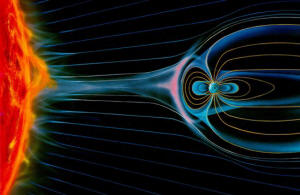
This is when we see the
Aurora Borealis in our night skies.
But strange things are happening in
both outer and inner space
The Earth's magnetic field has been decreasing. This decrease
actually began 2000 years ago, but the rate of decrease suddenly
became much more rapid 500 years ago.
Now, in the last 20 years or so, the
magnetic field has become erratic. Aeronautical maps of the world
-
which are used to allow airplanes to land using automatic pilot
systems - have had to be revised worldwide in order for the
automatic pilot systems to work.
Late last year, the Arctic ice cap on the exact spot of the North
Pole completely melted for the first time in known history. Green
Peace reported that, relative to the winter ice pattern, the cap had
previously melted over 300 miles toward the pole, and that late last
year both military and civilian ships were able to actually pass
directly over the North Pole. It was water.
Until now, as far as we know, there has
never been a time where the ice was less than ten feet thick.
In contrast, the South Pole has an ice
cap that is about three miles deep, and yet huge pieces of ice
continue to break off and melt.
There is a now a Giant Breach in the
Earth's Magnetic Field
NASA's five THEMIS spacecraft have discovered a breach in Earth's
magnetic field ten times larger than anything previously thought to
exist.
When this happens, solar wind can flow
in through the opening to "load up" the magnetosphere for powerful
geomagnetic storms. Exploring the mystery is a key goal of the
THEMIS mission, launched in
February 2007.
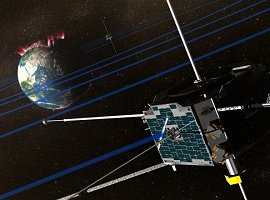
The big discovery came on June 3, 2007,
when the five probes serendipitously flew through the breach just as
it was opening. Onboard sensors recorded a torrent of solar wind
particles streaming into the magnetosphere, signaling an event of
unexpected size and importance. But the breach itself is not the
biggest surprise.
Researchers are even more amazed and
baffled at the unexpected way it forms, overturning long-held ideas
of space physics.
"At first I didn't believe it," says
THEMIS project scientist David Sibeck of the Goddard
Space Flight Center. "This finding fundamentally alters our
understanding of the solar wind-magnetosphere interaction."
"The opening was huge - four times
wider than Earth itself," says Wenhui Li, a space
physicist at the University of New Hampshire who has been
analyzing the data. Li's colleague Jimmy Raeder, also of
New Hampshire, says "1027 particles per second were
flowing into the magnetosphere - that's a 1 followed by 27 zeros.
This kind of influx is an order of magnitude greater than what
we thought was possible."
Scientists
Surprised
The size of the breach shocked researchers.
"We've seen things like this
before," says Li's colleague Jimmy Raeder, "but never on such a
large scale."
The entire day-side of the magnetosphere
was open to the solar wind.
This is changing our understanding of the universe. Space physicists
have long believed that holes in Earth's magnetosphere open only in
response to solar magnetic fields that point south. The great breach
of June 2007, however, opened in response to a solar magnetic field
that pointed north.
To the lay person, this may sound like a quibble, but to a space
physicist, it is almost seismic.
It means that something is happening
out there that they didn't predict and that is what has them
frightened.
Unexpected
Shield Drop
Here is where the scientific understanding our how magnetic field is
changing: What is understood today in the scientific community is
that the solar wind presses against the Earth's magnetosphere almost
directly above the equator where our planet's magnetic field points
north.
Scientists previously believed that if a
bundle of solar magnetism came along, and points north, too, the two
fields should reinforce one another strengthening Earth's magnetic
defenses and slamming the door shut on the solar wind.
In the language of space physics, a
north-pointing solar magnetic field is called a "northern IMF"
and it is synonymous with shields up.
The big surprise is that when a northern IMF came along, the
shields went down. This is completely overturning many
scientists understanding of things. As researchers investigated the
tear in the magnetic field, they discovered that twenty times more
solar wind passed into the Earth's protective shield when the
magnetic fields were aligned.
Northern IMF events don't actually
trigger geomagnetic storms, notes Raeder, but they do set the stage
for storms by loading the magnetosphere with plasma. A loaded
magnetosphere is primed for auroras, power outages, and other
disturbances that can result when a
CME (coronal mass ejection)
hits.
This means the impact of solar flares are twenty times as strong
with the magnetic lines are aligned. Earth's and the sun's magnetic
fields will be in sync at the solar cycle's peak, expected in
2012.
This will cause an influx of solar particles.
What the scientists didn’t discuss is
the impact on the human bioelectrical system.
The earth's
magnetic field impacts climate
The earth's climate has been significantly affected by the planet's
magnetic field, according to a Danish study published in January
2009 that could challenge the notion that human emissions are
responsible for global warming.
"Our results show a strong
correlation between the strength of the earth's magnetic field
and the amount of precipitation in the tropics," one of the two
Danish geophysicists behind the study, Mads Faurschou Knudsen
of the geology department at Aarhus University in western
Denmark, told the Videnskab journal.
The results of the study, which has also
been published in US scientific journal Geology, lend support to a
controversial theory published a decade ago by Danish astrophysicist
Henrik Svensmark, who claimed the climate was highly
influenced by galactic cosmic ray (GCR)
particles penetrating the earth's atmosphere.
What Drives Earth's Magnetic Field?
When an electric current passes
through a metal wire, a magnetic field forms around that wire
Likewise, a wire passing through a magnetic field creates an
electric current within the wire. This is the basic principle that
allows electric motors and generators to operate.
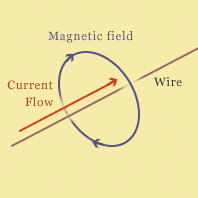
In the Earth, the liquid metal that makes up the outer core passes
through a magnetic field, which causes an electric current to flow
within the liquid metal. The electric current, in turn, creates its
own magnetic field - one that is stronger than the field that created
it in the first place.
As liquid metal passes through the stronger field, more current
flows, which increases the field still further. This self-sustaining
loop is known as the
geomagnetic dynamo.
Material from the liquid outer core
slowly "freezes" onto the inner
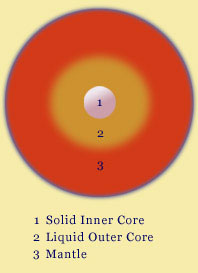 core,
releasing heat as it does so. (High pressures within the Earth cause
material to freeze at high temperatures.) core,
releasing heat as it does so. (High pressures within the Earth cause
material to freeze at high temperatures.)
This heat drives convection cells within
the liquid core, which keeps the liquid metal moving through the
magnetic field.
Energy is needed to keep the dynamo running.
This energy comes from
the release of heat from the surface of the solid inner core. Our
planet's spinning motion causes the moving liquid metal to spiral,
in a way similar to how it affects weather systems on the Earth's
surface. These spiraling eddies allow separate magnetic fields to
align and combine forces.
Without the effects caused by the spinning Earth, the magnetic
fields generated within the liquid core would cancel one another out
and result in no distinct north or south magnetic poles.
Rapid changes in the churning movement of Earth's liquid outer core
are weakening the magnetic field in some regions of the planet's
surface, a new study says:
"What is so surprising is that
rapid, almost sudden, changes take place in the Earth's magnetic
field," said study co-author Nils Olsen, a geophysicist
at the Danish National Space Center in Copenhagen.
The findings suggest similarly quick
changes are simultaneously occurring in the liquid metal, 1,900
miles (3,000 kilometers) below the surface, he said. Fluctuations in
the magnetic field have occurred in several far-flung regions of
Earth, the researchers found.
The changes,
"may suggest the possibility of
an upcoming reversal of the geomagnetic field," said study
co-author Mioara Mandea, a scientist at the German
Research Centre for Geosciences in Potsdam.
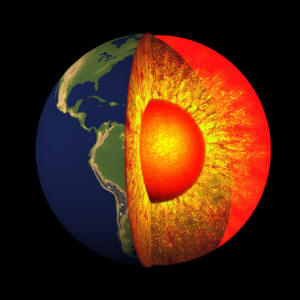
Earth's magnetic field has reversed
hundreds of times over the past billion years, and the process could
take thousands of years to complete.
The decline in the magnetic field also is opening Earth's upper
atmosphere to intense charged particle radiation, scientists say.
Cosmic Rays
are slamming Earth
An international team of researchers has discovered a puzzling
surplus of high-energy electrons bombarding Earth from space. The
source of these cosmic rays is unknown, but it must be close to the
solar system and it could be made of dark matter.
Their results are being reported in the
Nov. 20th issue of the journal Nature.
"This is a big discovery," says
co-author John Wefel of Louisiana State University. "It's
the first time we've seen a discrete source of accelerated
cosmic rays standing out from the general galactic background."
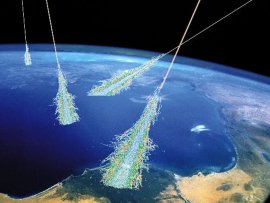
To study the most powerful and
interesting cosmic rays, Wefel and colleagues have spent the last
eight years flying a series of balloons through the stratosphere
over
Antarctica.
Their NASA-funded cosmic ray detector found an significant surplus
of high-energy electrons.
"The source of these exotic
electrons must be relatively close to the solar system - no more
than a
kiloparsec (one thousand
parsecs - approximately 3,262 light years) away," says
co-author Jim Adams of the NASA Marshall Space Flight
Center.
Galactic cosmic rays are subatomic
particles accelerated to almost light speed by distant supernova
explosions and other violent events. They swarm through the Milky
Way, forming a haze of high energy particles that enter the solar
system from all directions.
Cosmic rays consist mostly of protons and heavier atomic nuclei with
a dash of electrons and photons spicing the mix. Why must the source
be nearby?
Adams explains:
"High-energy electrons lose energy
rapidly as they fly through the galaxy.
They give up energy in two main ways:
-
when they collide with
lower-energy photons, a process called inverse Compton
scattering
-
when they radiate away some
of their energy by spiraling through the galaxy's
magnetic field."
High-energy electrons are therefore
local but the researches cannot pinpoint the source in the sky.
According to the research, this source would need to be within about
3,000 light years of the sun. It could be an exotic object such as a
pulsar, mini-quasar, supernova remnant or an intermediate mass black
hole.
The Sun
The sun is a massive electromagnetic broadcaster which floods the
planets of the solar system with heat, light, UV radiation, and
electrically charged particles.
The Sun itself has a magnetic field, and
that magnetic field creates an "egg" around the Solar System that is
known as the "heliosphere." The heliosphere is shaped like a
teardrop, with the long, thin end of the drop pointing away from the
direction in which we're traveling.
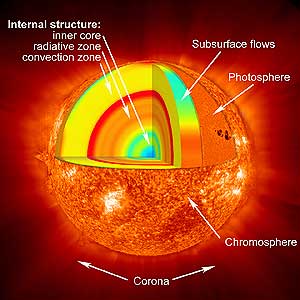
The Sun is the center of our Solar
System, and all life that is on this Earth came from the Sun. If
there were no Sun, we would not be alive. This is simply scientific
fact. And so any changes that occur in or on the Sun will eventually
affect every person alive.
The solar activity during this last
sunspot cycle was greater than anything ever seen before.
The Sun's magnetic field has changed in
the last 100 years
One recent study by Dr. Mike Lockwood from Rutherford
Appleton National Laboratories in California has been
investigating the Sun activity for the last hundred years. He
reports that since 1901 the overall magnetic field of the Sun has
become stronger by 230 percent.
Scientists do not understand what that
means for us.
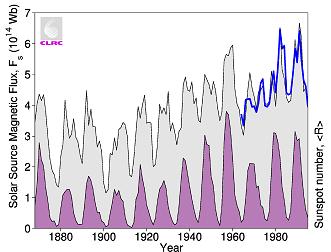
Some of the sunspot activity in this
last cycle was greater than anything ever recorded before in
history.
But scientists claim that they don't
understand what means either.
"Obviously, the sun is Earth's life
blood," said Richard Fisher, director of the
Heliophysics division at NASA. "To mitigate possible public
safety issues, it is vital that we better understand extreme
space weather events caused by the sun's activity."
According to NASA, it is beginning
another 11-year cycle of activity
The Sun flips its Magnetic Poles every eleven years.
Considering that the Sun is to blame
for some unfavorable climate changes on the Earth, the coming
decade could spell more trouble for our planet. The years ahead
could be intense.
Raeder explains:
"We're entering Solar Cycle 24.
For reasons not fully understood, CMEs in even-numbered solar
cycles (like 24) tend to hit Earth with a leading edge that is
magnetized north. Such a CME (coronal mass ejection) should open
a breach and load the magnetosphere with plasma just before the
storm gets underway. It's the perfect sequence for a really big
event."
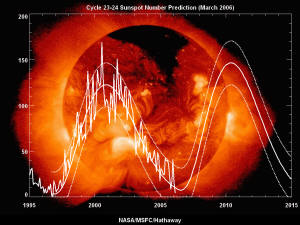
Every 10–11 years, the number of
sunspots found on our closest star rise from 0 (as it is currently
in 2008) to a high of over 400.
While the sunspots themselves don't
affect Earth, the solar flares and other disturbances emanating from
our sun during increased sunspot activity result in an increased
number of particles (electrons and protons) and harmful light
radiation (ultraviolet and x-rays), known as solar wind.
If it weren't for Earth's protective
magnetic field and atmosphere, this bombardment of particles would
burn us to a crisp.
Sunspot Cycle 24 peaking around 2012
could be one of the strongest in centuries
The next sunspot cycle will be 30-50% stronger than the last one and
begin as much as a year late, according to a breakthrough forecast
using a computer model of solar dynamics developed by scientists at
the National Center for Atmospheric Research (NCAR).
Predicting the Sun's cycles accurately,
years in advance, will help societies plan for active bouts of solar
storms, which can slow satellite orbits, disrupt communications, and
bring down power systems.
The scientists have confidence in the forecast because, in a series
of test runs, the newly developed model simulated the strength of
the past eight solar cycles with more than 98% accuracy. The
forecasts are generated, in part, by tracking the subsurface
movements of the sunspot remnants of the previous two solar cycles.
The team is publishing its forecast in
the current issue of Geophysical Research Letters.
Solar Cycle 25 peaking around 2022
could be one of the weakest in centuries
The Great Conveyor Belt is a massive circulating current of
fire (hot plasma) within the Sun. It has two branches, north and
south, each taking about 40 years to perform one complete circuit.
Researchers believe the turning of the
belt controls the sunspot cycle, and that's why the slowdown is
important.
"Normally, the conveyor belt moves
about 1 meter per second - walking pace," says Hathaway. "That's
how it has been since the late 19th century."
In recent years, however, the belt has
decelerated to 0.75 m/s in the north and 0.35 m/s in the south.
"We've never seen speeds so low."
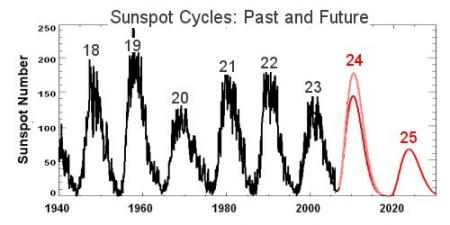
According to theory and observation, the
speed of the belt foretells the intensity of sunspot activity ~20
years in the future. A slow belt means lower solar activity; a fast
belt means stronger activity.
"The slowdown we see now means that
Solar Cycle 25, peaking around the year 2022, could be one of
the weakest in centuries," says Hathaway.
History of measuring solar flare
activity
The first measuring instruments made their appearance 440 years ago.
They showed that our nearest star treats the Earth to more than just
solar eclipses.
Sunspots, solar flares, faculae and
other phenomena affect everything on the Earth: from atmospheric
events to human behavior. These phenomena are known collectively as
solar activity. This activity, expressing itself through bursts of
solar radiation, magnetic storms or fiery flares, can vary in
intensity, from very low to very strong.
It is the storms that pose the greatest
danger to civilization.
History of solar activity affecting the
grid
On August 28, 1859, polar lights glowed and shimmered all over the
American continent as darkness fell.
Many people thought their city was
aflame. The instruments used to record this magnetic fluctuation
across the world went off their scales. Telegraph systems
malfunctioned, hit by a massive surge in voltage. It was perhaps the
worst in the past 200 years and with the advent of modern power
grids and satellites, much more is at risk.
This was an actual solar storm. Its results for humankind were
small, because civilization had not yet entered a hi-tech phase of
development. Had something similar happen in our nuclear space age,
destruction would have been catastrophic. Meanwhile, according to
scientific data, storms of such size occur relatively seldom: once
in five centuries. But events with half the intensity happen every
50 years.
The last one took place on November 13, 1960 and disturbed the
Earth's geomagnetic fields, upsetting the operation of radio
stations.
How this could
impact our grid today
Now our dependence on radio electronic devices is so immense that
increased solar activity could disable life-support systems all over
the world, and not only on the surface. Poor space weather makes all
orbital systems malfunction.
A heavy solar storm can cause disruption
to space-based navigation systems. NASA is now sounding an
alarm because our continent is so close to the northern magnetic
pole and is the most vulnerable to solar activity.
A study by the
MetaTech Corporation revealed that
an impact similar to that of 1859 would incapacitate the entire
electricity grid in North America. Even the relatively weak magnetic
storm of 1989, provoked by solar activity, caused an accident at a
Canadian hydro-electric power plant that left 6 million people in
the U.S. and Canada without electric power for nine hours.
A new study from the National Academy of Sciences also
outlines grim possibilities on Earth for a worst-case scenario solar
storm. Modern power grids are so interconnected that a big space
storm - the type expected to occur about once a century
- could
cause a cascade of failures that would sweep across the United
States, cutting power to 130 million people or more in this country
alone, the new report concludes.
Such widespread power outages, though
expected to be a rare possibility, would affect other vital systems.
"Impacts would be felt on
interdependent infrastructures with, for example, potable water
distribution affected within several hours; perishable foods and
medications lost in 12-24 hours; immediate or eventual loss of
heating/air conditioning, sewage disposal, phone service,
transportation, fuel resupply and so on," the report states.
Outages could take months to fix, the
researchers say.
Banks might close, and trade with other
countries might halt.
"Emergency services would be
strained, and command and control might be lost," write the
researchers, led by Daniel Baker, director of the
Laboratory for Atmospheric and Space Physics at the University
of Colorado in Boulder.
Could cycles of war and peace be tied
to cycles of the sun?
Some researchers claim that
geomagnetic storms affect brain waves and hormone levels, causing a
number of different reactions, predominately in males.
While a few women may also experience
changes during these storms, they generally seem less affected by
the sun's behavior. Reacting to changing hormone
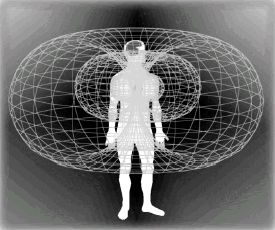 levels,
some men may become increasingly irritable and aggressive, while
others may instead become more creative. levels,
some men may become increasingly irritable and aggressive, while
others may instead become more creative.
An increase in solar activity is found to increase psychotic
episodes in individuals who already suffer from unstable
psychological states.
While we might relate such behavior to a full
moon, in 1963, Dr. Robert Becker and his colleague, Dr.
Freedman, demonstrated that solar changes also lead to a
noticeable increase in psychotic activity.
Yet these reactions are not simply
isolated to a few particularly sensitive or unlucky individuals.
Evidence indicates that wars and international conflicts most often
break out when sunspots are rapidly forming or rapidly decaying, as
these are times when there are more intense geomagnetic storms.
In
addition, this increase in solar activity also correlates to periods
of more accidents and illness, as well as an increase of crimes and
murders. The entire biosphere is affected by this electromagnetic
pollution, and human behavior seems to react accordingly.
Not all geomagnetic storms are disruptive. But over time, these
extremes in solar activity may also affect periods of earthly
conflict. The data on cycles of war and peace extend back at least
2,500 years. (Some believe that they may be traced even further, but
the records are not as reliable.)
Although some may argue that it seems as
if there is always war somewhere, records show that periods of
conflict increase and decrease in nearly regular cycles.
Scientific Investigations into solar
activity and a possible effect on society
As early as 1915, some scientists were beginning to recognize
connections between solar activity and human behavior.
This work
began with Russian scientist Alexander Chizhevsky, who
observed that mass changes in human behavior correlated to
sunspot cycles.
In the 1930s, Professor Raymond Wheeler, a historian at the
University of Kansas, took this observation one step further. His
research afforded numerical rankings to the severity of individual
battles correlating to solar cycles. His data was statistically
analyzed by Edward Dewey, who validated the existence of these war
cycles.
Yet he was unable to make a definite connection with sunspot
cycles because the data at that time was insufficient. In the 1980s,
with a more detailed analysis of Wheeler's data, the connection
became clear.
Upon close examination of the data, It appears that we are beginning
to discover a pattern to emerge where wars are most likely to start
in key points of the sunspot cycle.
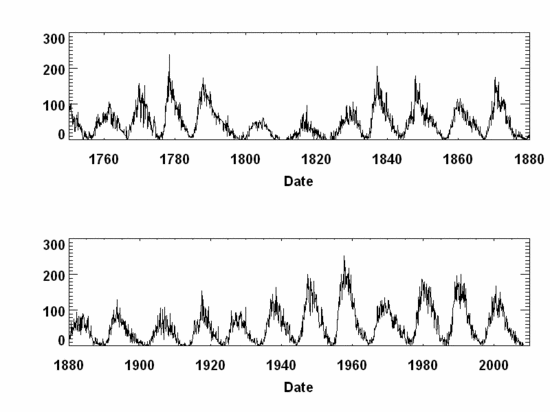
This is when the geomagnetic activity is changing most rapidly on
the upsurge of solar activity, or the downward part of the cycle,
when sunspots are rapidly diminishing. In addition we can also see
how this affects physiological mechanisms, such as altered brain
rhythms and abnormal hormonal levels.
In other words, wars could be a kind of mass psychosis.
When we see the connection to physical
mechanisms (electromagnetic pollution), this gives us some
predictive insight for when increased aggressions were apt to start.
Calculations indicate that we're due to see another rise in intense
solar activity in about two years: September 22, 2010.
NASA predicts that this will peak
in
2012.
Animals can detect changes in the
Earth's magnetic field
The internal compasses of
some animals might work by detecting minute changes in the pace of
biochemical reactions in different magnetic fields, researchers in
the US suggested in June 2000.
Many creatures, including some birds, amphibians and reptiles,
navigate by sensing tiny changes in the Earth's magnetic field. Sea
turtles, for instance, can sense changes as small as a tenth of a
microtesla - less than 0.2 per cent of the typical geomagnetic
field.
But nobody knows exactly how these biological compasses work. One
theory is that the magnetite molecules found in some tissues act
just like miniature compass needles.
Another is that animals sense changes in
biochemical reaction rates caused by differing magnetic fields,
which are known to alter the pace of a wide range of chemical
reactions.
Studies in
Russia
Some Russian scientists say that these same changes taking place now
within our solar system and planet were occurring when the dinosaurs
became extinct - a time that marked a gigantic shift in the earth's
climate and weather patterns, and perhaps a pole shift, as well.
Our planet hasn't flipped its Magnetic
Poles in 780,000 years and may be long overdue.
Scientists from the Russian National Academy of Science in
Siberia have come to the conclusion that we have moved into an
area of space that is different and has a much higher
energy level. The Russians are reporting changes that are being
recorded in space that have never been seen before. The
Russians have looked at the leading edge of our sun's heliosphere
and they have observed glowing plasma energy.
The Russian National Academy of Sciences doesn't give us a
time-line, but the change from what was known and accepted to the
way it is now represents a 1000 percent increase. And the Russians
say that this change in the Sun is changing how the planets function
and what kind of life they could support.
They even report - but don't explain
-
that
the DNA spiral itself is altering.
They feel that the continued expansion of the heliosphere will
eventually take us into a new level of energy, that there will
probably be a sudden expansion of the basic harmonic wavelengths
that the Sun emits as it radiates energy out of itself, and that
this increase in energy emission will change the basic nature of all
matter in the Solar System.
Sun's
protective 'bubble' is shrinking
New data has revealed that the heliosphere, the protective shield of
energy that surrounds our solar system, has weakened by 25 per cent
over the past decade and is now at it lowest level since the space
race began 50 years ago.

Scientists are baffled at what could be causing the barrier to
shrink in this way and are to launch mission to study the
heliosphere.
Dr Nathan Schwadron,
co-investigator on the IBEX mission at Boston University, said:
"Around 90 per cent of the galactic
cosmic radiation is deflected by our heliosphere, so the
boundary protects us from this harsh galactic environment."
The heliosphere is created by the solar
wind, a combination of electrically charged particles and magnetic
fields that emanate a more than a million miles an hour from the
sun, meet the intergalactic gas that fills the gaps in space between
solar systems. Without the heliosphere the harmful intergalactic
cosmic radiation would make life on Earth almost impossible by
destroying DNA and making the climate uninhabitable.
If the heliosphere continues to weaken, scientists fear that the
amount of cosmic radiation reaching the inner parts of our solar
system, including Earth, will increase.
This could result in:
Sun Blamed for
Warming of Earth and Other Worlds
It has also been postulated that this is the real reason for both
global warming since higher energy levels of the Milky Way are
almost certain to cause our Sun to burn hotter and emit higher
energies.
This is why other planets in the solar
system, like
Mars, Neptune, and Pluto are also warming up.
Temperatures have been seen to rise on virtually all the planets in
our system.
This seems quite apart from any local phenomenon like
greenhouse gases etc.
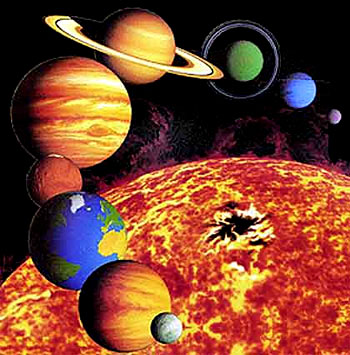
Habibullo Abdussamatov, the head of space research at St.
Petersburg's Pulkovo Astronomical Observatory in Russia,
recently linked the attenuation of ice caps on Mars to fluctuations
in the sun's output.
Abdussamatov also blamed solar fluctuations for
Earth’s current global warming trend. His initial comments were
published online by National Geographic News.
Benny Peiser, a social anthropologist at Liverpool John
Moores University who monitors studies and news reports of
asteroids, global warming and other potentially apocalyptic topics,
recently quoted in his daily electronic newsletter the following
from a
blog called
Strata-Sphere:
“Global warming on Neptune's moon
Triton as well as Jupiter and Pluto, and now Mars has some
[scientists] scratching their heads over what could possibly be
in common with the warming of all these planets ... Could there
be something in common with all the planets in our solar system
that might cause them all to warm at the same time?”
During a 75-year period beginning in
1645, astronomers detected almost no sunspot activity on the Sun.
Called the “Maunder
Minimum,” this event coincided with the coldest part of
the
Little Ice Age, a 350-year cold
spell that gripped much of Europe and North America.
New Studies Indicate how sounds from
the sun affect earthquakes on earth
Scientists from the
European Space Agency's Ulysses mission
have proven that sounds generated deep inside the Sun cause the
Earth to shake and vibrate in
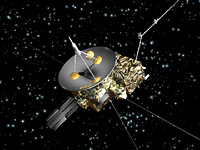 sympathy. sympathy.
They have found that Earth’s magnetic
field, atmosphere and terrestrial systems, all take part in this
cosmic sing-along.
Although these tones are all around us, it would not be possible for
us to hear them, even if we listened very closely. Their pitch is
too low for the human ear, typically 100-5000 microHertz (1
microHertz corresponds to 1 vibration every 278 hours).
The scientists say data from the Ulysses project provided an
important clue as to how these sounds generated deep inside the Sun
reach the Earth.
Measurements made by the Ulysses deep
space probe, which was launched in 1990 to orbit the sun, have shown
that the pressure created inside the heliosphere by the solar wind
has been decreasing.
Here's How it Works
The researchers believe that the key to the problem is magnetism.
They suggests that specific tones
described as g-mode vibrations are picked up by the magnetic field
at the Sun’s surface. Part of this magnetic field is then carried
away from Sun into interplanetary space by solar wind. The magnetic
field of the solar wind in turn interacts with the Earth’s magnetic
field and causes it to vibrate in sympathy, retaining the
characteristic g-mode signals.
The motions of the geomagnetic field then couple into the solid
Earth to produce small, but easily detectable, responses as Earth,
with many of its technological systems, moves to the rhythm of the
Sun.
The Solar
System
The atmospheres of five of the planets and the Earth's moon
are changing.
The earth's atmosphere in the upper
levels is forming HO gas that didn't exist in the quantity that it
does now. The Scientists from the Russian National Academy of
Science say it's not related to global warming, CFCs or
fluorocarbon emissions. They claim the atmospheres of Jupiter,
Uranus and Neptune are also are changing. The Martian atmosphere is
getting sizably thicker than it was before.
The Mars Observer probe in 1997 lost one of its mirrors,
which caused it to crash.
This happened because the atmosphere
was about twice as dense as NASA had calculated.
The brightness and magnetic field of
the planets is changing
Venus is showing marked increases in its overall brightness.
Jupiter's energetic charge has risen so high that there is actually
a visible tube of ionizing radiation that's formed between the
surface of Jupiter and
its moon Io. You can actually see
the luminous energy tube in photographs that have been taken
recently.
Uranus and Neptune also are becoming brighter. The magnetic fields
of Jupiter, Uranus, and Neptune are changing. Jupiter's magnetic
field has more than doubled and Neptune's magnetic field is
increasing. All three of these planets are becoming brighter, and
their atmospheric qualities, say the Russians, are changing - but
they do not explain what is meant by this.
The Russians report that Uranus and Neptune appear to have had
recent pole shifts.
When the Voyager II space probe flew
past Uranus and Neptune, the apparent north and south magnetic poles
were sizably offset from where the rotational pole was in earlier
recordings. In one case, it was 50 degrees off, and in the other
case the difference was around 40 degrees.
What Is Going On?
Since 1900 we have gone from
riding horses to launching satellites into space.
From sending letters by horseback to
firing them off with instantaneous email, cell phones, and faxes. On
the other hand, we have gone from warring with primitive weapons to
atomic bombs and bioterrorism.
And perhaps even more significantly, in 1900 the Earth had 30
million species, species which took billions of years to create.
Now, we have less than half that number - fewer than 15 million
species. And this all happened in 100 years: a geological
blink of an eye.
Disturbingly, we may be at the bring of
World War Three following an
economic crash of the world
economy.
This new information about the changes in our solar system comes at
an interesting time for our planet.
It could be possible that for some time
celestial events may have been playing their part in shaping our way
of life on the planet, and that these changes that we are now seeing
with our sun, magnetic field, and solar system may be the very thing
that changes our world as we know it into something new.
Only time will tell, but it appears that the future may already be
here...
|






 core,
releasing heat as it does so. (High pressures within the Earth cause
material to freeze at high temperatures.)
core,
releasing heat as it does so. (High pressures within the Earth cause
material to freeze at high temperatures.) 





 levels,
some men may become increasingly irritable and aggressive, while
others may instead become more creative.
levels,
some men may become increasingly irritable and aggressive, while
others may instead become more creative.


 sympathy.
sympathy.